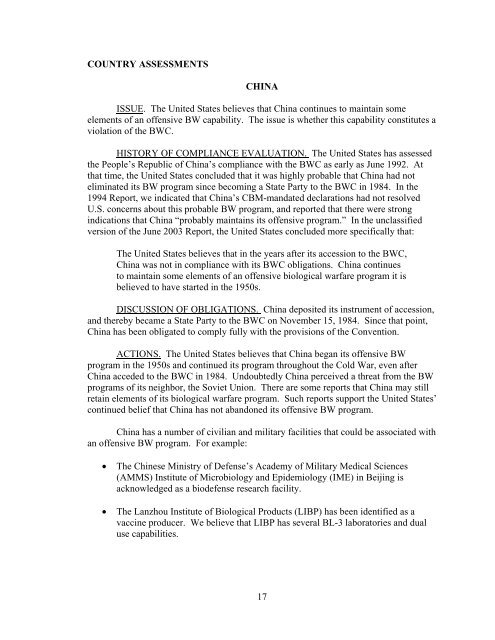Adherence to and Compliance with Arms Control, Nonproliferation ...
Adherence to and Compliance with Arms Control, Nonproliferation ...
Adherence to and Compliance with Arms Control, Nonproliferation ...
Create successful ePaper yourself
Turn your PDF publications into a flip-book with our unique Google optimized e-Paper software.
COUNTRY ASSESSMENTS<br />
CHINA<br />
UISSUEU. The United States believes that China continues <strong>to</strong> maintain some<br />
elements of an offensive BW capability. The issue is whether this capability constitutes a<br />
violation of the BWC.<br />
UHISTORY OF COMPLIANCE EVALUATION. U The United States has assessed<br />
the People’s Republic of China’s compliance <strong>with</strong> the BWC as early as June 1992. At<br />
that time, the United States concluded that it was highly probable that China had not<br />
eliminated its BW program since becoming a State Party <strong>to</strong> the BWC in 1984. In the<br />
1994 Report, we indicated that China’s CBM-m<strong>and</strong>ated declarations had not resolved<br />
U.S. concerns about this probable BW program, <strong>and</strong> reported that there were strong<br />
indications that China “probably maintains its offensive program.” In the unclassified<br />
version of the June 2003 Report, the United States concluded more specifically that:<br />
The United States believes that in the years after its accession <strong>to</strong> the BWC,<br />
China was not in compliance <strong>with</strong> its BWC obligations. China continues<br />
<strong>to</strong> maintain some elements of an offensive biological warfare program it is<br />
believed <strong>to</strong> have started in the 1950s.<br />
UDISCUSSION OF OBLIGATIONS. U China deposited its instrument of accession,<br />
<strong>and</strong> thereby became a State Party <strong>to</strong> the BWC on November 15, 1984. Since that point,<br />
China has been obligated <strong>to</strong> comply fully <strong>with</strong> the provisions of the Convention.<br />
UACTIONS.U The United States believes that China began its offensive BW<br />
program in the 1950s <strong>and</strong> continued its program throughout the Cold War, even after<br />
China acceded <strong>to</strong> the BWC in 1984. Undoubtedly China perceived a threat from the BW<br />
programs of its neighbor, the Soviet Union. There are some reports that China may still<br />
retain elements of its biological warfare program. Such reports support the United States’<br />
continued belief that China has not ab<strong>and</strong>oned its offensive BW program.<br />
China has a number of civilian <strong>and</strong> military facilities that could be associated <strong>with</strong><br />
an offensive BW program. For example:<br />
• The Chinese Ministry of Defense’s Academy of Military Medical Sciences<br />
(AMMS) Institute of Microbiology <strong>and</strong> Epidemiology (IME) in Beijing is<br />
acknowledged as a biodefense research facility.<br />
• The Lanzhou Institute of Biological Products (LIBP) has been identified as a<br />
vaccine producer. We believe that LIBP has several BL-3 labora<strong>to</strong>ries <strong>and</strong> dual<br />
use capabilities.<br />
17















